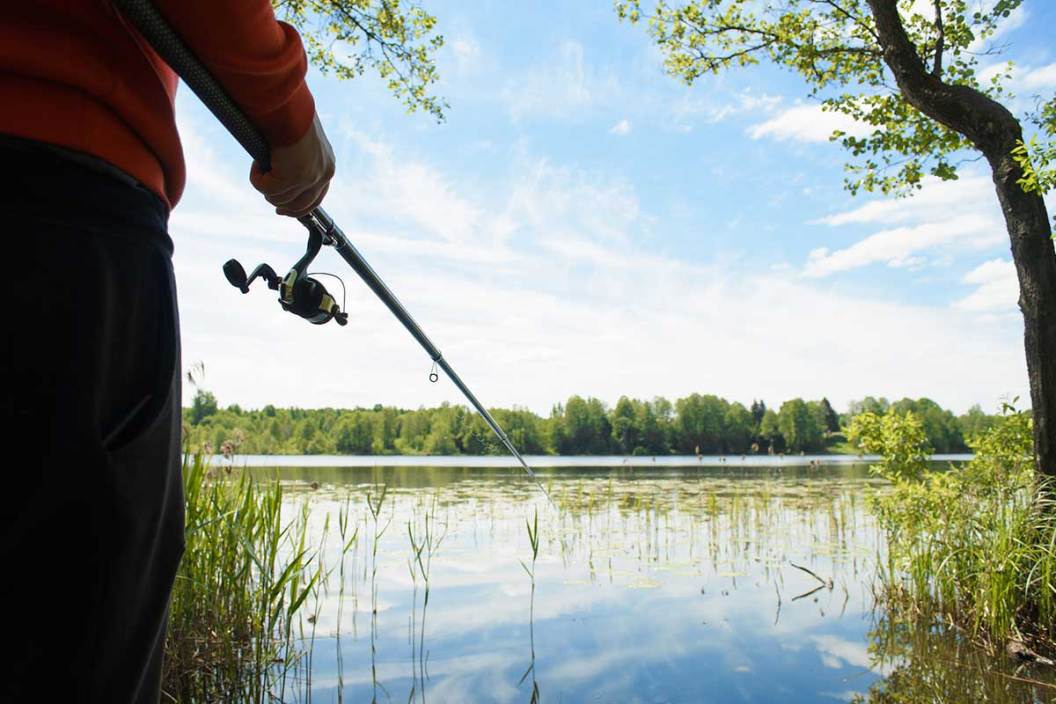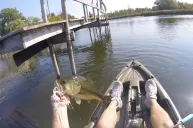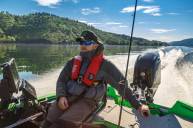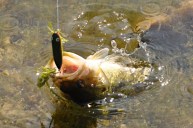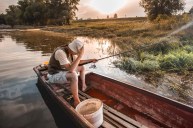Change your game with these three species-specific fishing tactics.
We wait all winter for the ice to disappear, because it's the fishing that we can't get enough of. Anglers everywhere understand that once the spring spawning runs are over, the fish sometimes seem to disappear.
That couldn't be further from the truth, but the lack of action as the summer season stretches on can be frustrating.
Obviously, finding where the fish are is the first part of the puzzle, and the second part is enticing them into striking your lure or bait. We know fish need to continue to feed throughout the year, it's just that the warmth of summer changes the way you need to target them.
Let's look at three of the most basic and popular fish species that we love to aim our baits at, and determine what it takes to make them enthusiastic during the dog days of summer.
Bass Fishing Tactic: Go Deep

Since the largemouth bass is generally the most desired fish to target, we'll start with that. It's generally known that cooler water holds more dissolved oxygen than warm water, so it stands to reason that you may need to go deeper to find what you're looking for.
For this deep water tactic to work, the angler must be ready to blindly cast into waters that may be replete with stumps, rocks, and sunken trees in the effort to get to the fish. Of course, good electronics will help a fisherman to get a handle on what is there before he or she makes their first cast, but even knowing that the structure is there doesn't prevent every snag.
In this case, an angler must be ready to bypass the little guys and dig deeper into the water column for larger fish that need cooler, more oxygenated water to thrive. Normally, a good bet is to use larger jig combos tipped with either a pork rind or a soft plastic that mimics the year's newer crawdads.
You will need lighter line in the 8- to 10-pound-test category to get your bait down to the desired depth quicker allowing the plastic to bounce near the bottom actively. To avoid a massive amount of your tackle lost due to hang-ups, a three-way swivel can actively keep your offering in the target zone longer and any snags will simply lose a weight or two.
Big bass can still be caught on buzzbaits in the early morning or the late evening when water temperatures are above 70 degrees, but when the dog days are upon us we need to start considering deep structure and drop-offs.
A good way to discover where the fish are holding is with deep diving crankbaits, especially along ledges. It also might be the best time of the year to stop at the local tackle shop and procure live bait like shiners, shad, or other minnows that fish are bound to hit.
When things seem to get slow, bass fishermen should slow down right along with it. We all love active, run-and-gun fishing, but sometimes a little sit-and-wait is just what the doctor ordered.
Walleye Fishing Tactic: Fast-Paced Experimentation
Summer is a great time to catch walleyes, and you can target big ones with a variety of different baits. As you may have heard, veteran walleye anglers like to rig up, get their rod and reel combos into the rod holders, and troll large areas to determine what the fish are doing.
Many walleye pros use the technique of fishing structure with their baits closer to the bottom. If they're out in open water, run them higher in the water column above suspending walleyes. This is where electronics can hold the key for finding fish that are more spread out but still actively feeding.
Experimentation is the key when you know the fish are there, but you can't quite garner a reaction.
Walleye anglers can get away with a faster trolling speed at this time of year since the water is warmer and the fish are always on the move. Try having several rods rigged with multiple different baits until the fish cooperate. When you find out what that is, it's time to rig them all the same.
Some walleye anglers on larger lakes and impoundments will go looking for fish over deeper structure. However, many veteran anglers will tell you that a certain percentage of fish will stay in the shallow weeds all throughout the season.
As stated, once the summer bite gets tough, finding the fish is one thing and getting them to strike is another.
Deepwater rocks, sunken humps, channels, and rises off the bottom in anywhere from 15 to 30 feet of water make for great places to find fish hanging out and looking to fill their bellies. Any good walleye spinner harness rig tipped with live bait works well by using a bullet sinker or a bottom bouncer to keep it down and give it life.
Sometimes walleyes will destroy typical stickbaits in typical colors such as a Rapala in basic black and white, and other times they will turn their nose up at that for that hot pink stickbait that has been languishing in the bottom of your tackle box for years. Bait that resembles nightcrawlers, leeches, and live minnows are also great options for walleye.
When fishing for walleye, it is important to remember that your bait should be bouncing off the bottom and not dragging on it. Fluorocarbon line as a leader for 20- to 30-pound-test braid works great since it gets down into the water quickly, disappears well, and leaves you with the strength needed to fight the toothy fish.
Northern Pike Fishing Tactic: Tap into the Hunter Instinct
As most anglers know, the northern pike (aka the water wolf) is one of the most aggressive, voracious predators in freshwater. In fact, sometimes they will attempt to strike, kill, and eat almost anything. Why does their aggression, and therefore our pike fishing effort, seem to slow down in the summer?
Pike, like any fish, have their ups and downs when it comes to the feeding process. As the water warms in the heat of the summer, they're going to shift their behavior. By the time the really warm weather rolls around, big pike have dispersed into multiple areas in many lake types. They can be found in places like shallow cabbage weed beds, hovering over the thermocline in deep water, keeping station around deep sunken islands, or cruising deep flats looking for prey.
This is why many anglers in the know prefer heavier action baitcasting rigs spooled up with 30-pound test braided line at the minimum.
Pike are routinely ambush critters that love to speed out of nowhere to eat their target before it even knows that it was eaten, mostly by detecting it well ahead of time. This is why baits that cause a commotion in the cover should be given a chance to prove themselves as northern pike attractors.
We've all learned that big baits catch big fish, and nowhere is this more true than in northern pike fishing. One of the best offerings that I've found over the years has to be the Terminator series of spinnerbaits. They come in every pattern imaginable, larger sizes, and the titanium body holds up seriously well against those sharp teeth.
At times, I've casted these vaunted baits right into the middle of a weed bed that bordered deeper water. I'm sure to work it hard to get it through the mess, while remaining ready for a strike at any moment. For those times when the weeds are deeper, a 1/2 to 3/4 ounce single hook spoon tipped with a large soft plastic can garner tremendous hits as well.
Swimbaits also work well for plying deep waters when pike seem to disappear in the summer. It's easy enough to find different styles and varieties of swimbaits since they've become so popular in recent years. Sometimes a leech pattern works the best and at other times an obvious minnow imitation is the key. My own father used to swear by the original Mepps comet minnow lure and he has the pictures to prove it. He would keep a 3/4-ounce sinker tied just ahead of it to go deep and reel nice and slowly.
When it finally happens, those strikes are where the angler needs to hold on for dear life. Pike will hit a bait like few other freshwater species can.
Even deep water pike see lots of pressure and respond better to these subtle baits. While subtle doesn't always mean small, it does mean slowing down, making less noise, and blending in more like a natural baitfish. that's the sort of formula that causes a pike to hunt it down. And you know how much pike like to hunt.
Fishing as the Summer Wanes
Jerkbaits and other topwater offerings seem to get discarded at this time of year, but not always. The warmest summer months mean watersports, picnics, and beautiful sunsets, but they don't have to mean crummy fishing.
Finesse fishing in the hot weather can mean more than just slow jigging or a deep shaky head worm rig, it also means slowing down and taking the time to find the fish. Sure, we all want to cast around the dock, or pitch the timber, but when it comes down to it the fish aren't so much different than we are. It's hot and they need a rest from all the activity.
Shallow water means warm water when the summer days slow down the action, which means it's time to try new things and test alternative approaches.
Products featured on Wide Open Spaces are independently selected by our editors. However, when you buy something through our links, we may earn a commission.
Looking for a little more or even hot lunch for your hunting blind? Follow my webpage, or on Facebook and YouTube.
NEXT: 5 ETHICAL FISHING QUANDARIES
